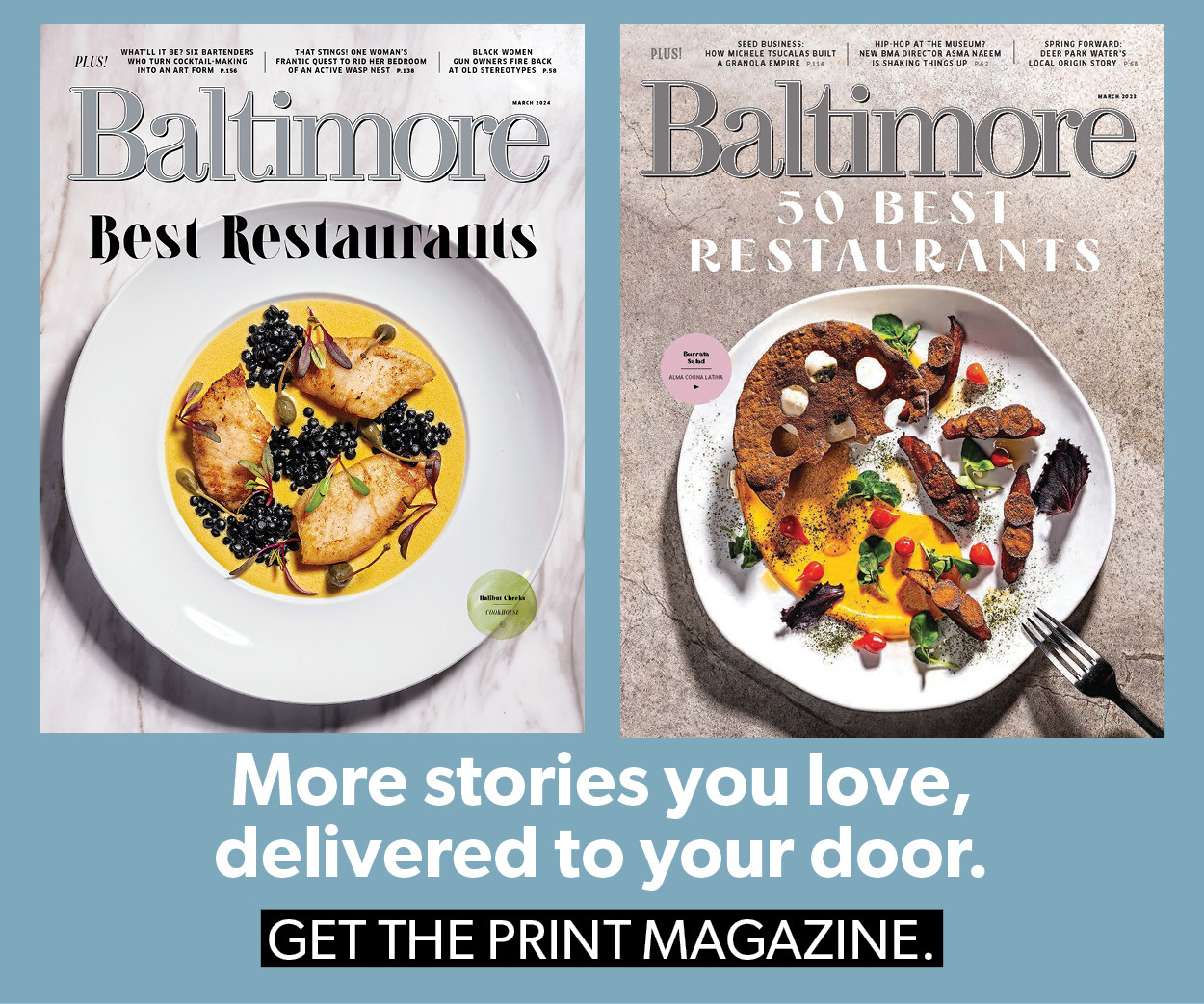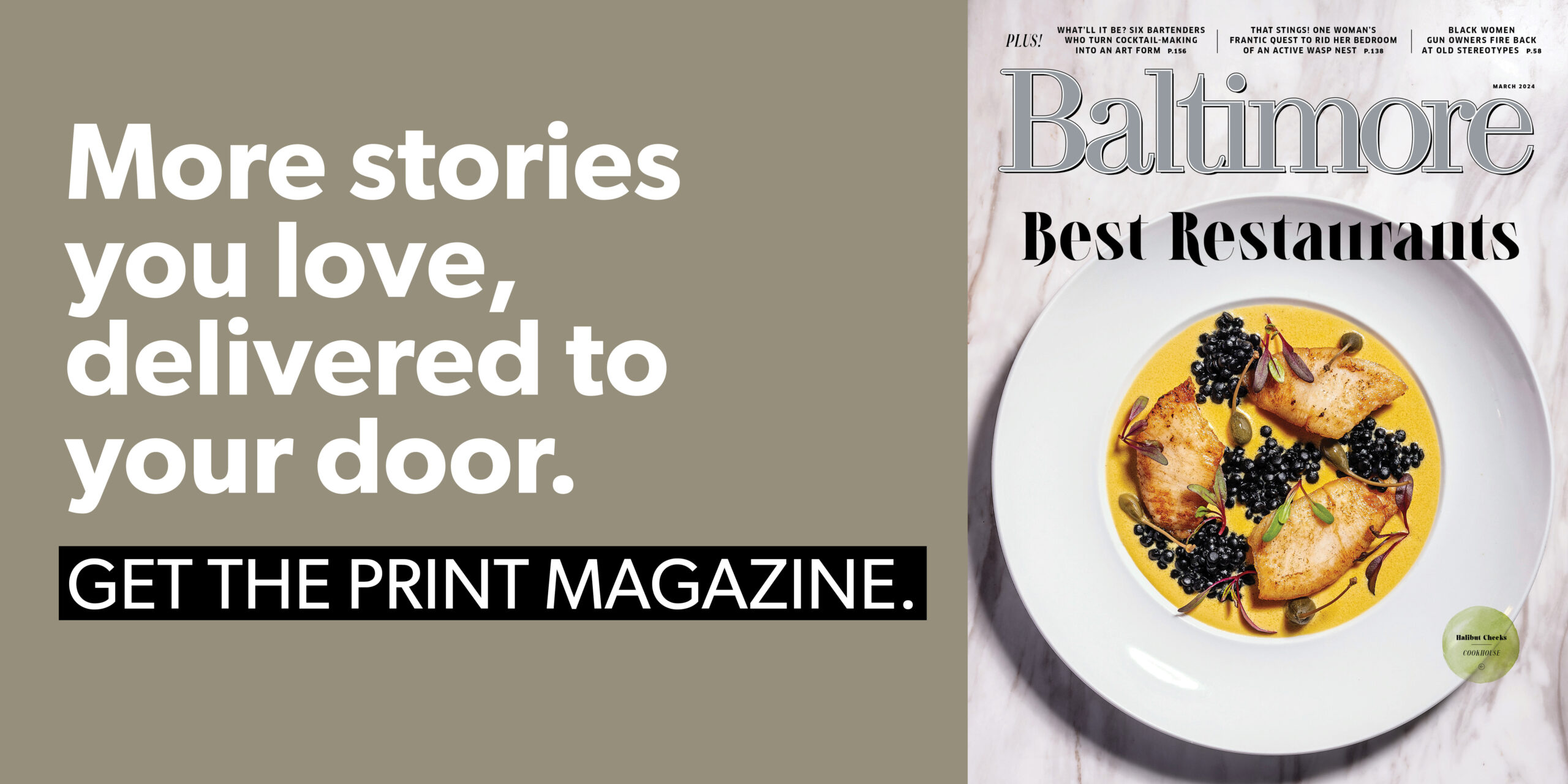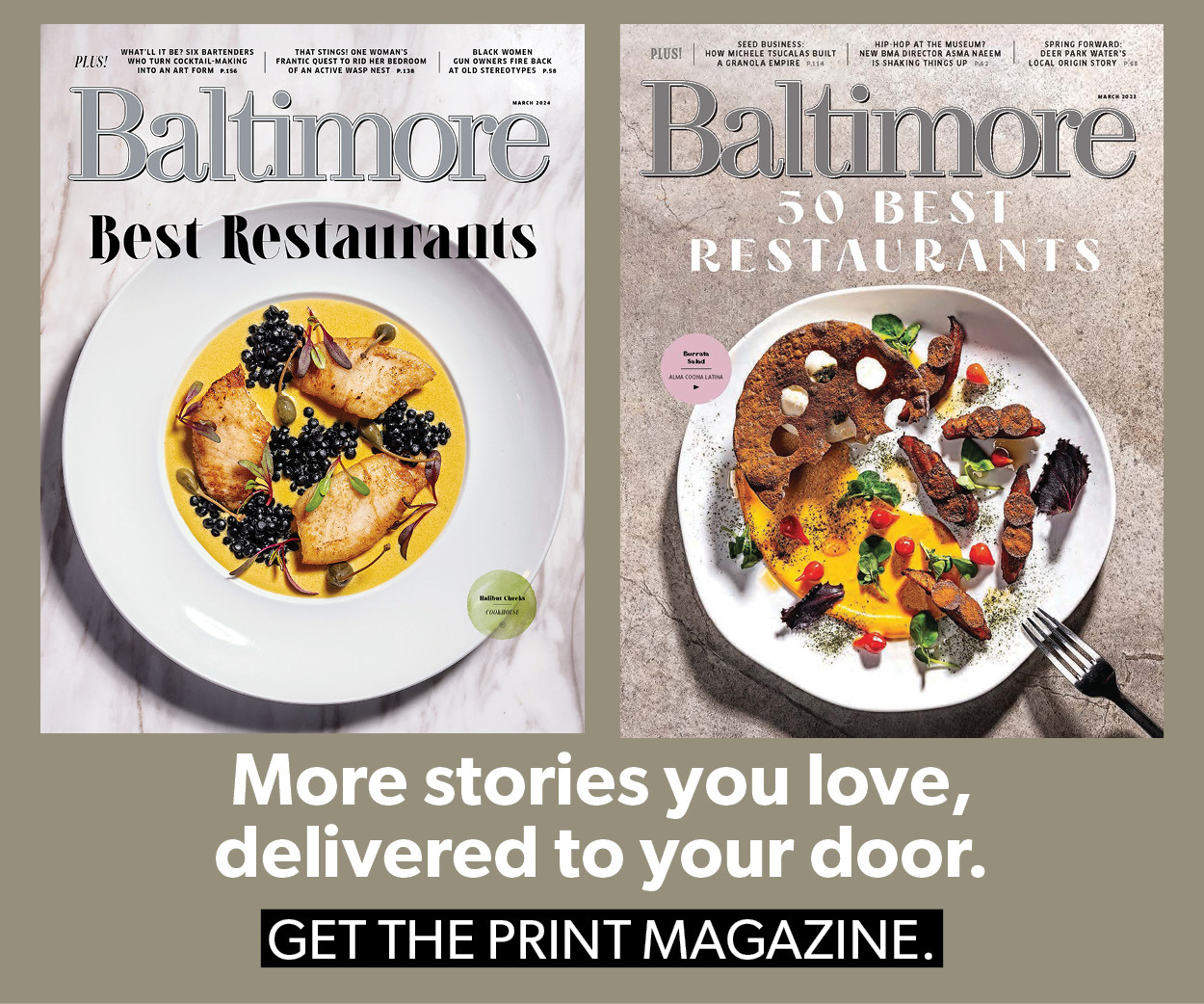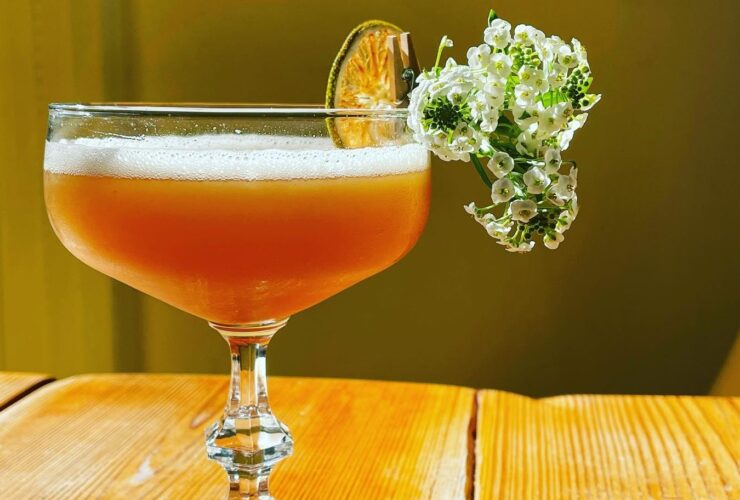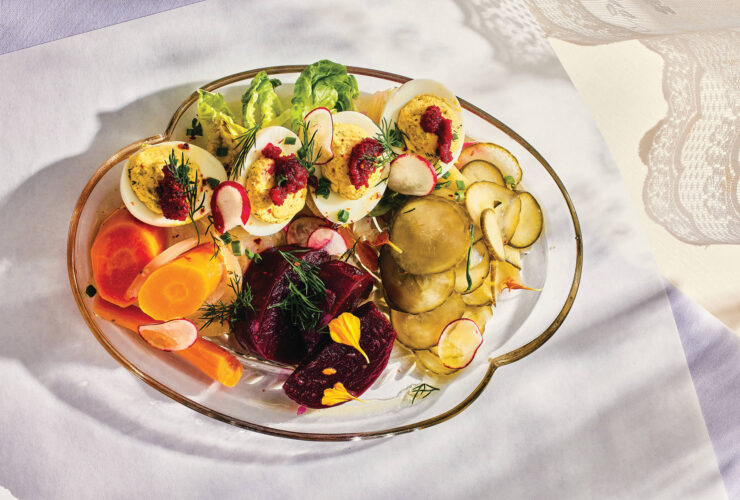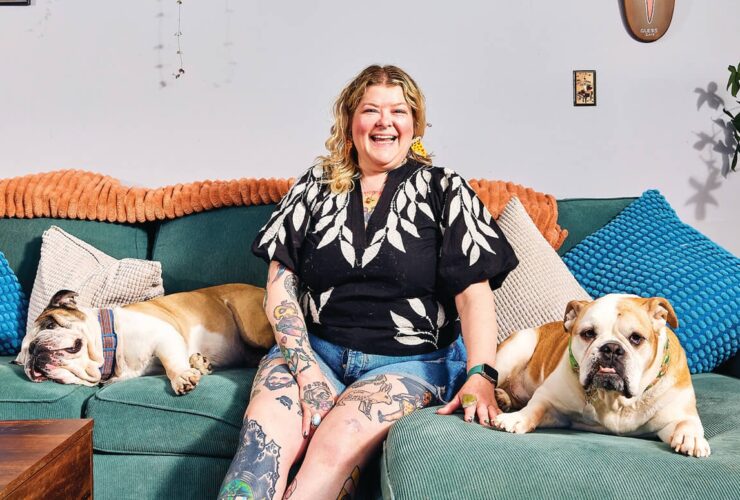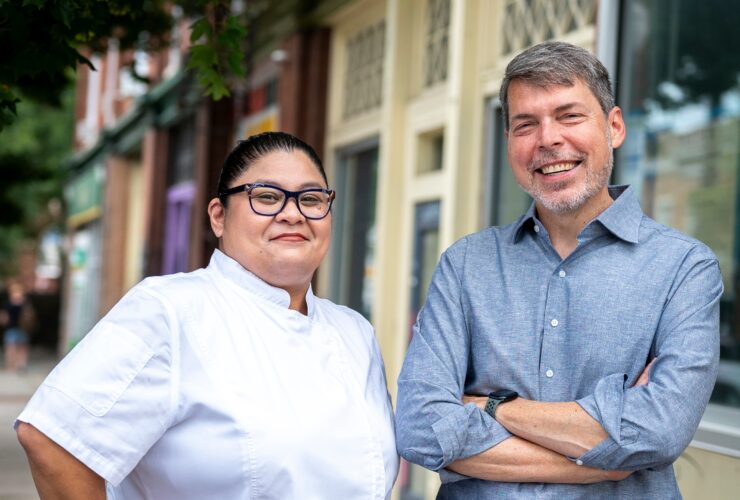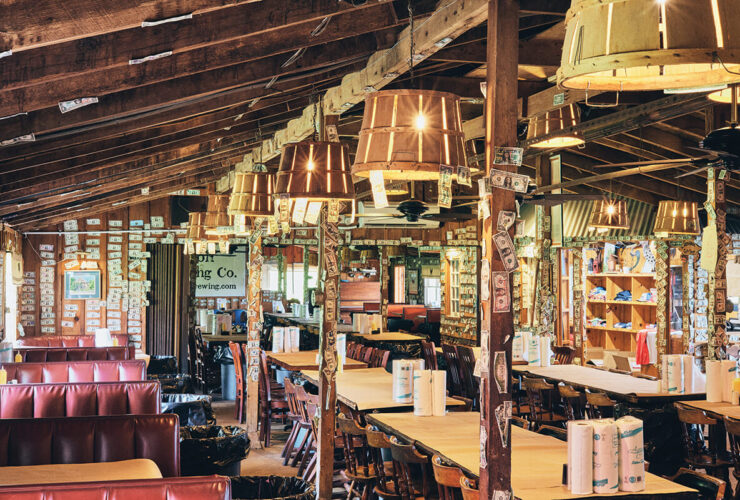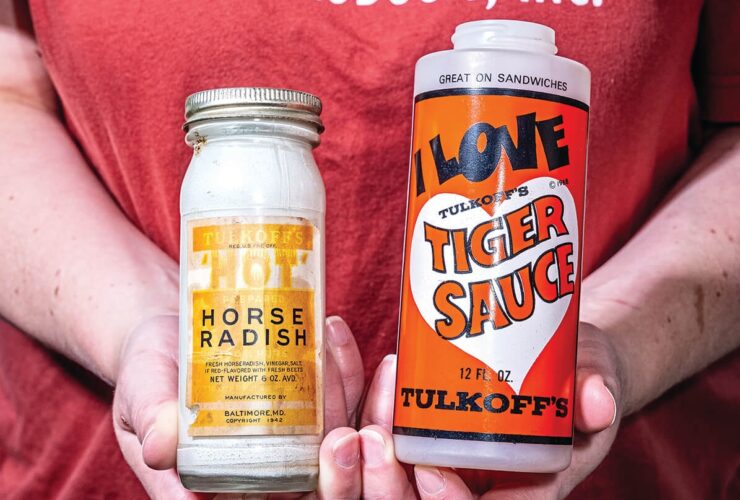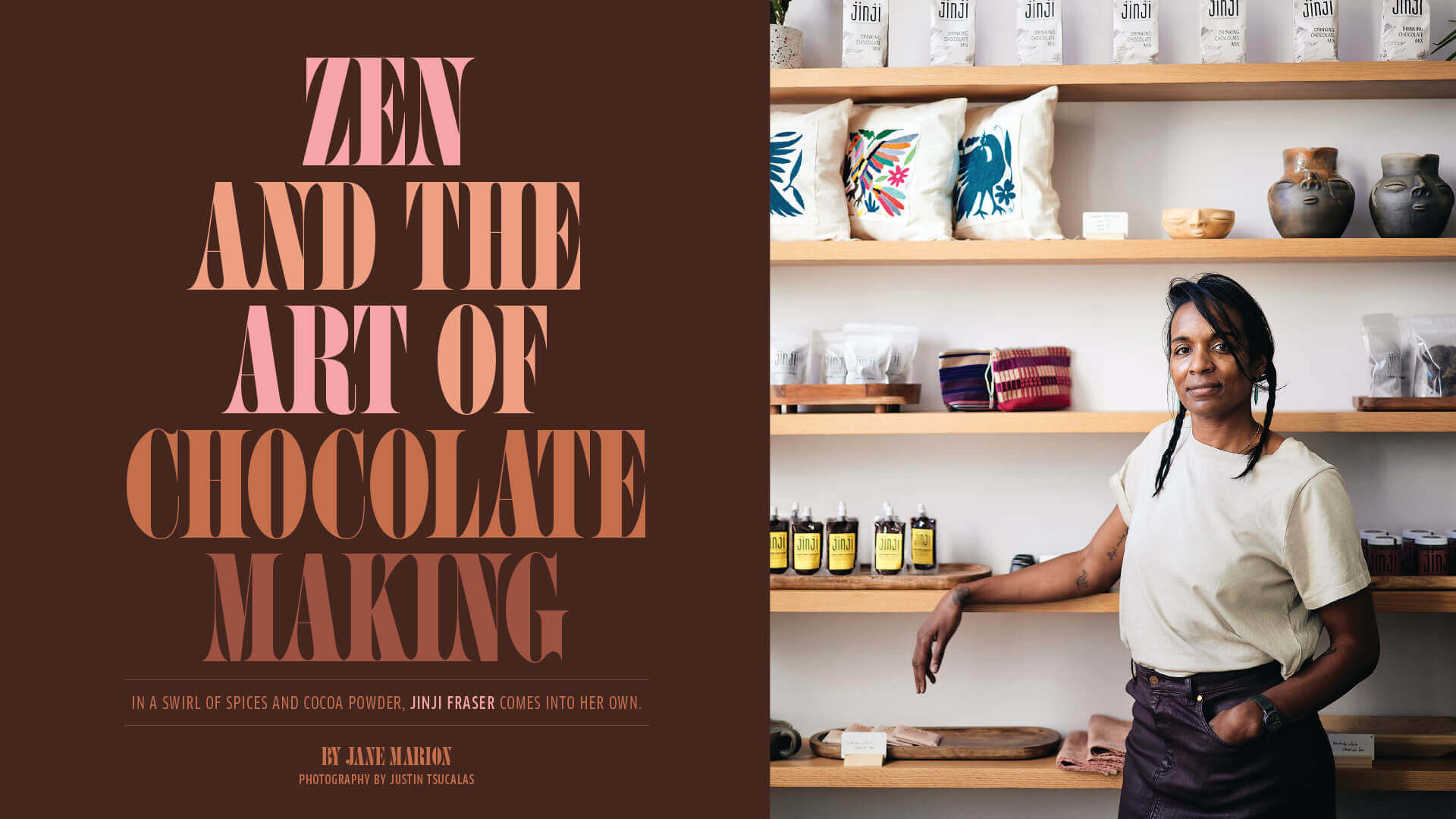
Food & Drink
Zen and the Art of Chocolate Making
In a swirl of spices and cocoa powder, Jinji Fraser comes into her own.
By Jane Marion
Photography by Justin Tsucalas
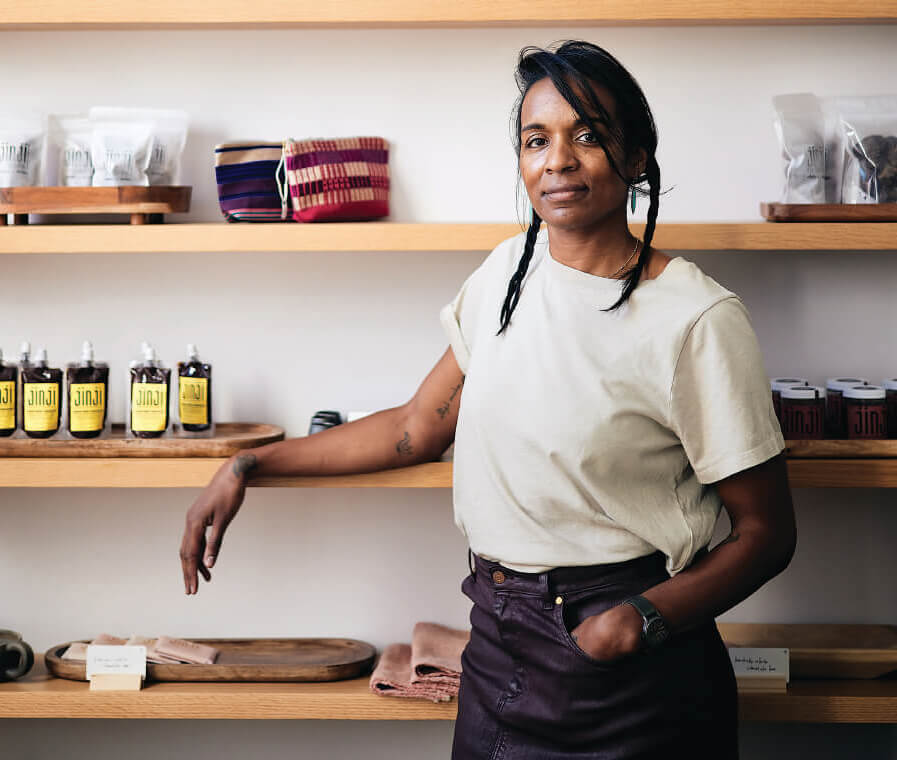
March 2024
OPENING SPREAD: Jinji Fraser stands in front of the wares at her new chocolate shop in Waverly, where she sources goods from her favorite cacao-growing regions.

a crisp fall day, sunlight spills through the nearly floor-to-ceiling windows inside Jinji Chocolate at the corner of Greenmount Avenue and 31st Street in Waverly. The circa-1873 Classical Revival-style building, with its Greek temple-like form, was once the neighborhood’s official town hall—a bustling political and civic centerpiece for the surrounding community. And in many ways, a century and a half later, the function of the space hasn’t changed.
Owner Jinji Fraser swings through the kitchen door of her charming confectionery to tend to patrons who’ve come in to buy truffles or fudge or, in some cases, nothing at all—many flock just to spend time with Fraser, who warmly greets each guest from behind the glass display case. “Are you a neighbor?” she asks some. “Is this your first time visiting?” she asks others.
Jinji’s Chocolate is a chocolate shop, first and foremost, filled with rows of truffles with currants and cranberries, piles of Tuskegee pecan turtles, lines of peanut butter fudge, and trays stacked with Turkish figs stuffed with peanut butter ganache. But ever since opening last October, it’s also quickly become a community hub, whether that means collaborating with neighbors like Local Color Flowers for an edible flower class, hosting a traditional mole dinner with Neopol Smokery, or providing a place for local musicians to perform as patrons stand at the high-top table and enjoy the vibe over cups of hot drinking chocolate.
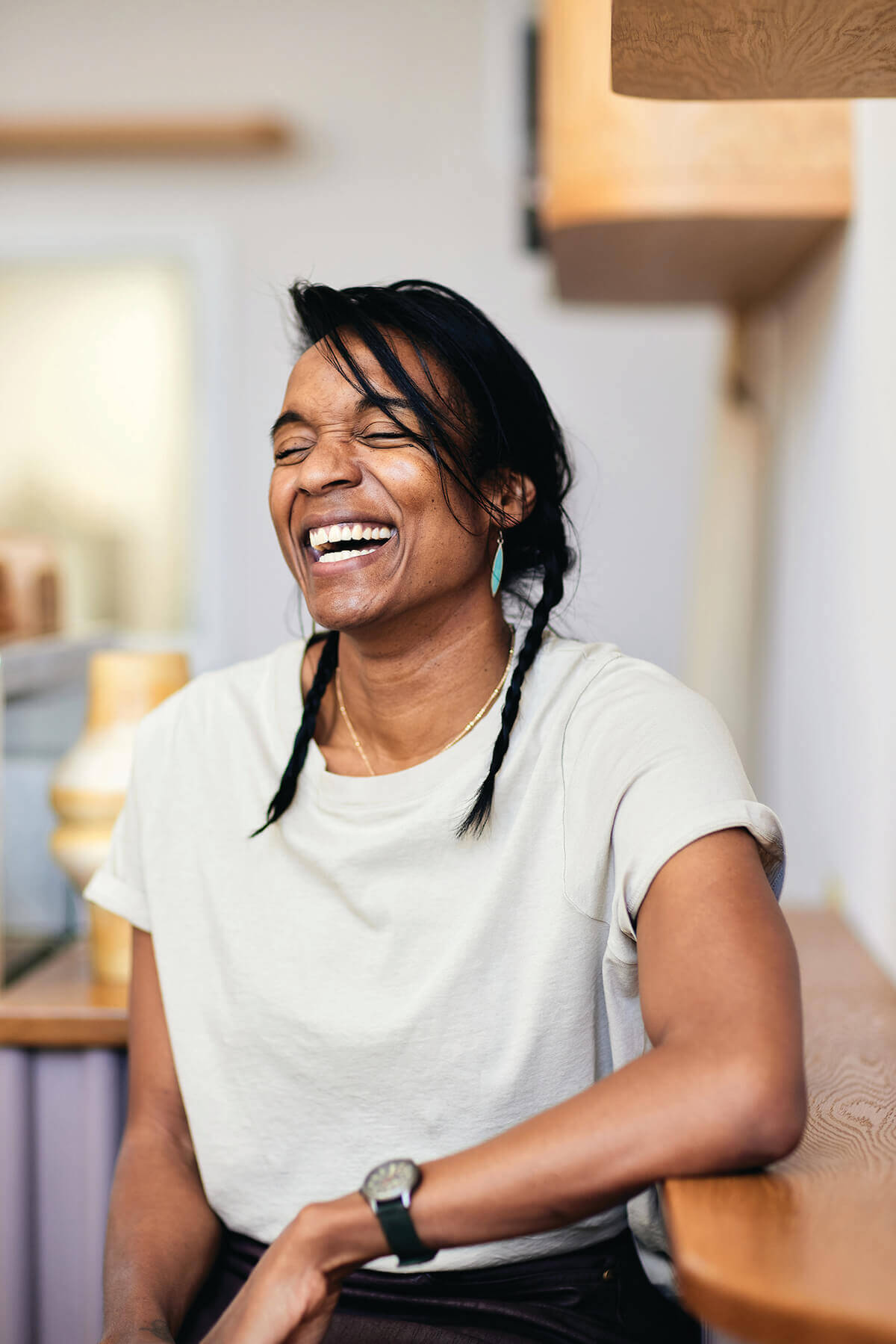
Fraser has a laugh.
“I love that feeling—of making a big city into a small town,” says Fraser. “I like to think our chocolate shop does that. . . . I don’t want people to come here when they’re in a hurry. I want them to come in, enjoy a drink, look around, and make a friend. Chocolate is such a communal thing—it should be a shared experience.”
Long before cacao percentages or artsy chocolate-bar labels became a trend, the ethereal 5-foot, 9-inch Fraser was building a loyal following at her small 80-square-foot stall in the Belvedere Square Market in North Baltimore. There, she became known for her responsibly sourced, mindfully made small-batch chocolates, and for imbuing her business with the kind of good intentions and positive spirit that can be a rarity in such a complicated industry—and world.
Of course, Baltimore has its share of established chocolatiers, such as the century-old Wockenfuss Candies in Parkville and Rheb’s Candies in Violetville. But Fraser, now something of a one-name wonder, is doing something entirely her own.
Unlike chocolatiers who work with ready-made chocolate, Fraser makes her own chocolate from scratch, from cacao butter and cacao powder processed at origin, or from cacao beans that she roasts and grinds on-site in Waverly.
But there’s more that makes her stand out from the pack. Not only is the 40-year-old, first-generation chocolate maker a Black woman in a white-male-dominated industry, but her interest in taking chocolate back to its indigenous roots—with a focus on ethical and sustainable practices—makes her a standout in a small-but-growing community of chocolate makers working to forge a more equitable future in their field.
“Chocolate is a very colonized industry,” she says. “But we can change that reality by being true to what chocolate has always been meant to be.”
To that end, Fraser imports her beans, some 800 pounds, from Golden Beans Estate, a small, female-owned, family-run farm that grows and hand-harvests their beans in Cedros, Trinidad, while cacao butter, cacao powder, and cacao nibs are purchased from Peru.
“A cacao tree will take five to seven years to reach maturity before it produces fruit,” she says. “The cacao pod is then pulled down by a machete and cracked open by hand, then the beans are all gathered in a heap and fermented over nine days and sun-dried in huge flat beds for about a week, depending on the humidity and weather, and then scooped into sacks and shipped out to wherever they are going—and all along, hands are touching the beans all the time...all the time.”
When the beans travel from Trinidad to Greenmount Avenue, they arrive in a large blue barrel with enough raw cacao beans to last many months. Over time, the beans will get roasted and ground into chocolate before being transformed into bars, while cacao butter and powder and nibs are turned into truffles, fudge, drinking chocolate, and other edible works of art.
Fraser tries to educate her customers about the fact that mass-produced, bulk-bean chocolate is manufactured from premade, often low-grade, highly processed chocolate that has been melted down. Combined with additives to keep it shelf-stable, mass-produced chocolate has little in common with craft chocolate, which preserves the raw natural flavors of the cacao, with other natural ingredients only included as a complement.
“We want to be truthful about what we are doing, and for us, that means so many things—the land itself hasn’t been overcrowded and has been carefully diversified,” says Fraser, alluding to the associated benefits for the health of the soil (and in turn the plants and then their beans). “It means that the people working there are getting paid in a way that they can take care of their families and that they have access to various resources when they need them. All those things are just obvious ways of being human and treating people decently.”
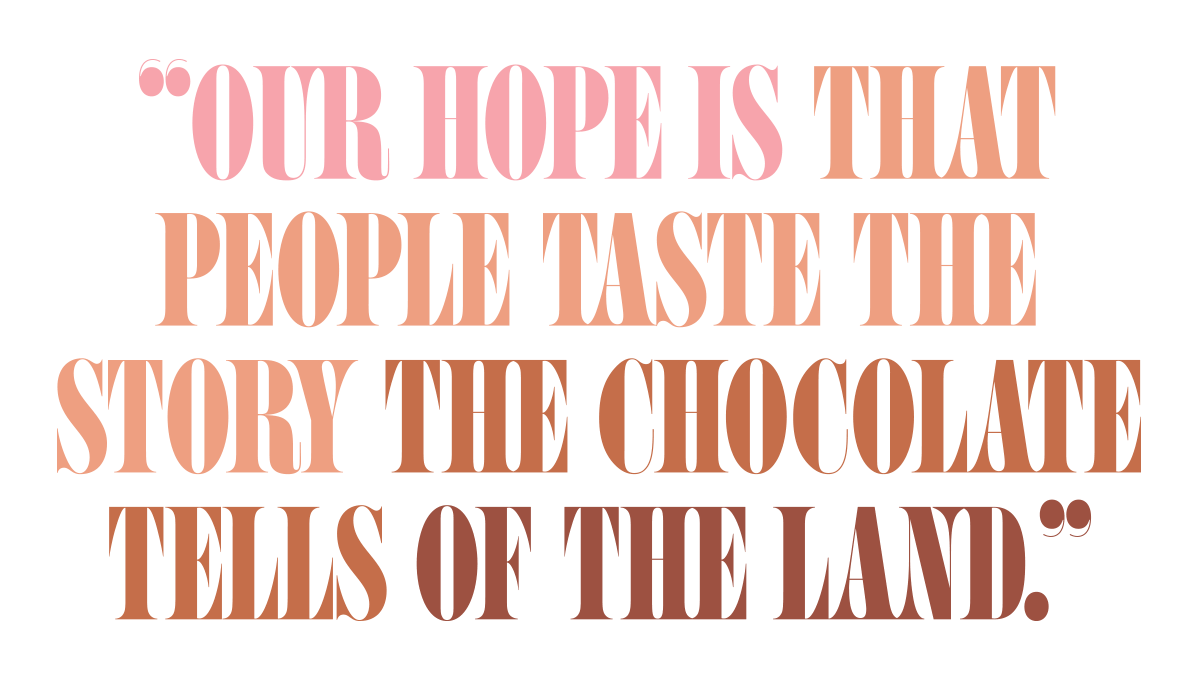
Above all, Fraser hopes her chocolate—rich, smooth, subtly sweet, and earthy—speaks for itself. “Our hope is that people taste the story the chocolate tells of the land and of the people who take care of the land and harvest the cacao,” says Fraser. “The chocolate itself has such a pure and distinct flavor. There’s a feeling that you get of, ‘Oh, this is something different.’”
The same can be said of the shop itself, a larger space that has afforded Fraser the freedom to stock shelves with stacks of the bean-to- bar white chocolate that now sit alongside home goods like embroidered pillows from Guatemala, handmade mugs from Mexico, and textured jugs from Peru, reflecting some of her favorite cacao-growing regions. “The space is literally 10 times as big as what we started with,” she says, “but we knew immediately how we were going to fill it.”
Of course, there’s also now plenty of workspace for her tiny, tight-knit team, which includes her father, Guy, who handles the bookkeeping; her husband, Paul, a BGE heavy equipment operator, who helped build the shop’s interior and is the on-call Mr. Fix-It; and her best friend and general manager, Jonathan Seton, who leads production.
Though only five months old, the chocolate shop has been a long time coming. Fraser dreamed of one day owning her own brick-and-mortar, and after years of searching for the right space—interrupted by the pandemic and the home birth of her son, Stokely—she finally happened upon the former city hall. And it was love at first sight.
“The light, the windows, the doors, it all felt very charming,” she says. “We almost signed a lease in Lauraville on April 1, 2020, but not moving until now was a silver lining.”
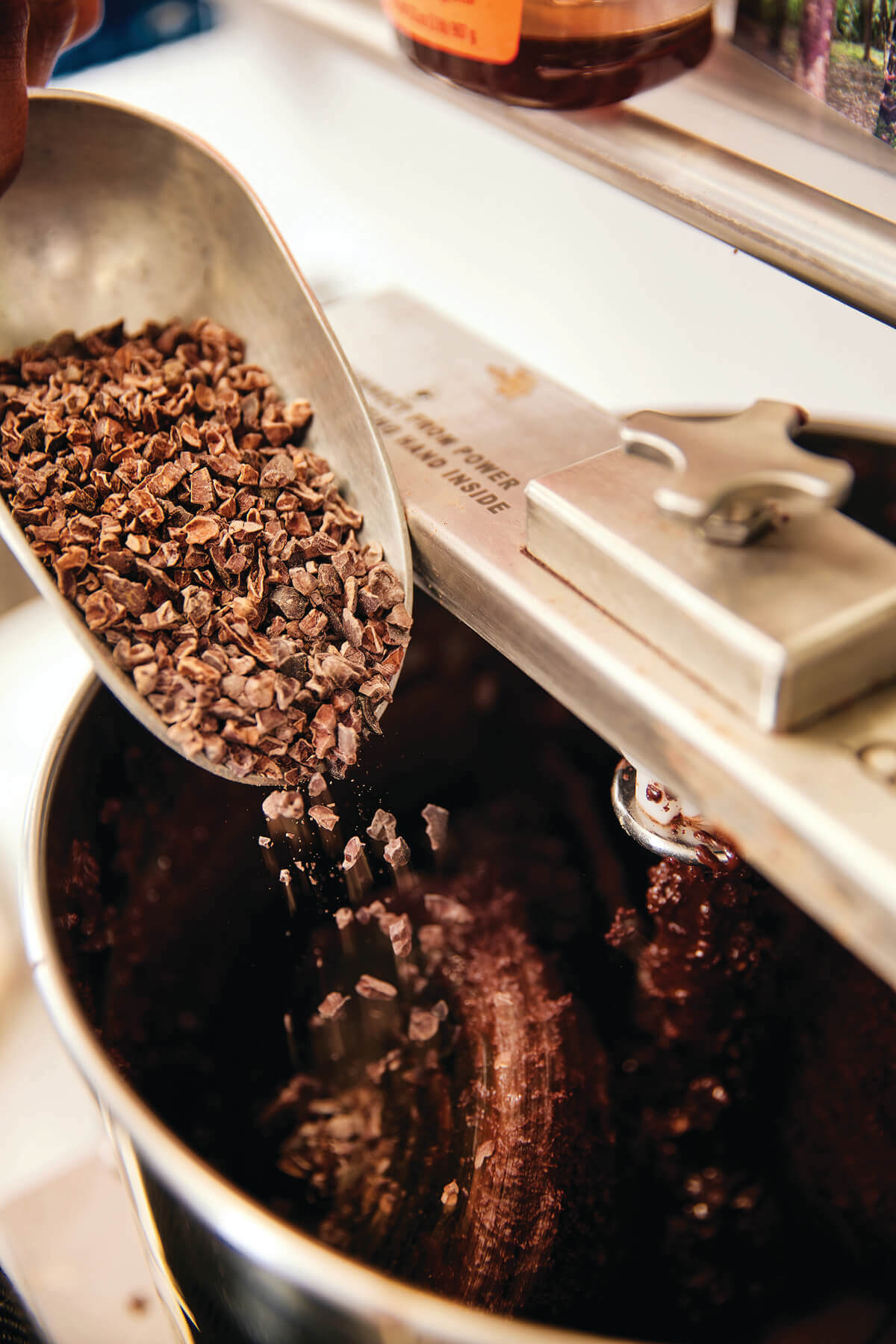
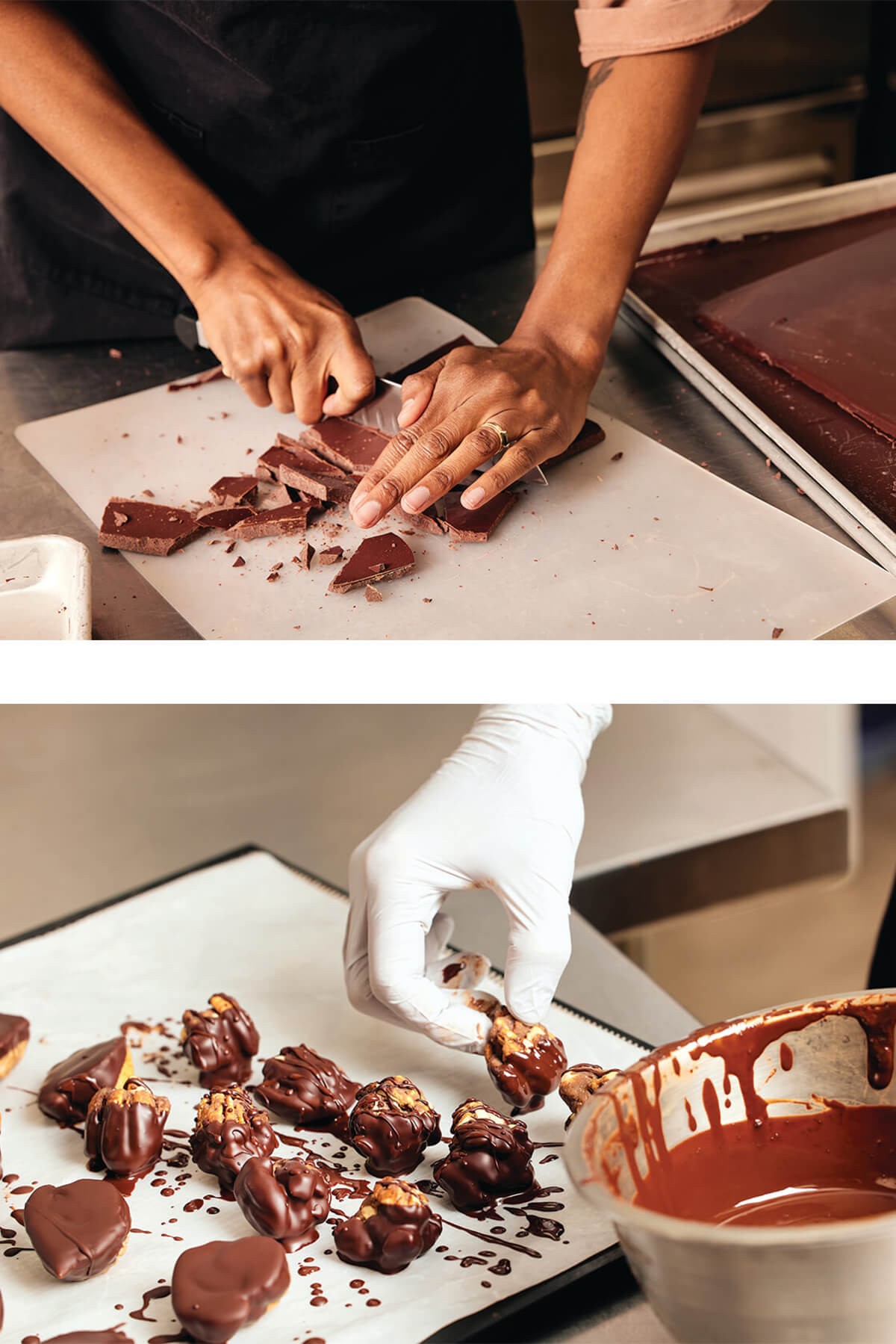
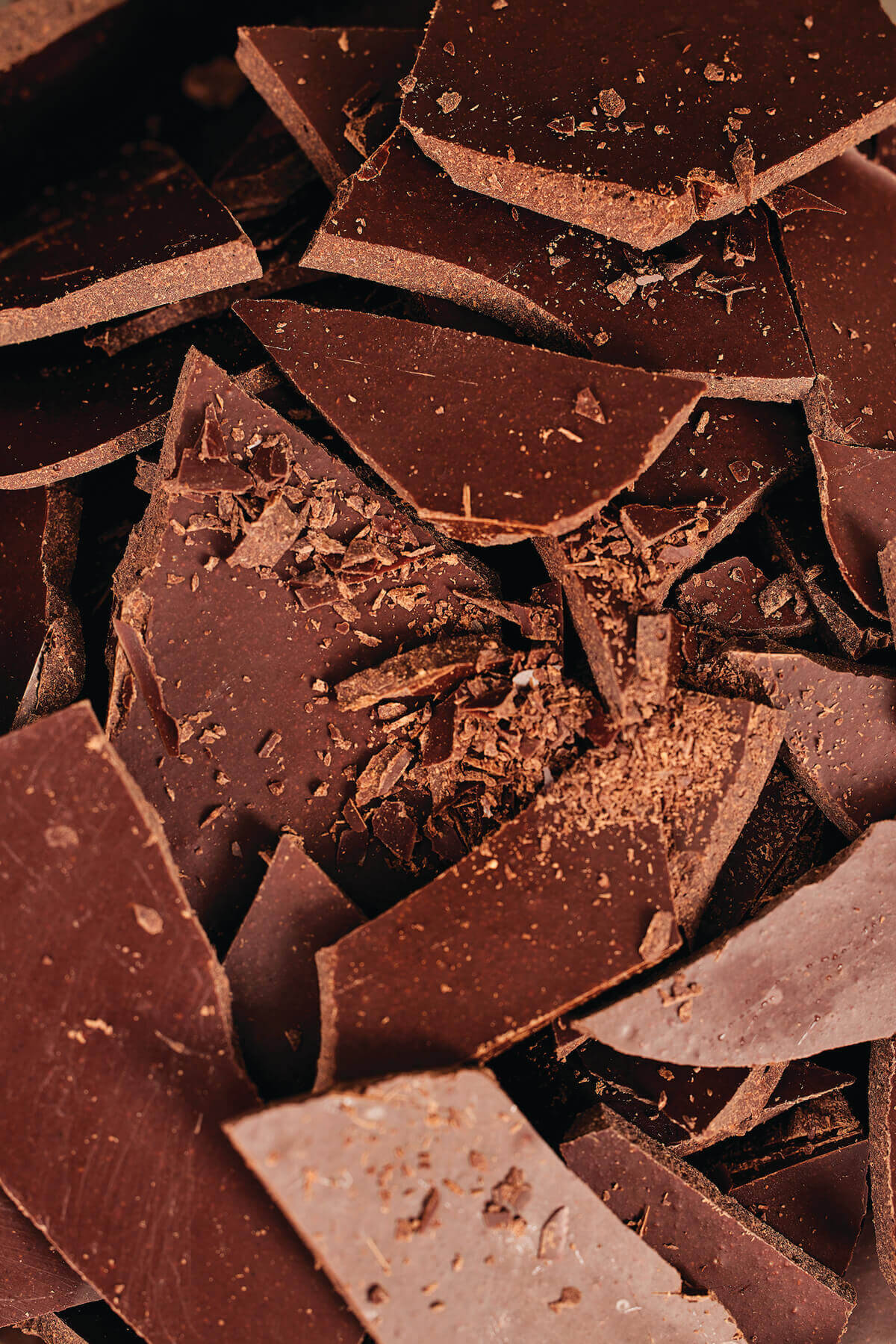
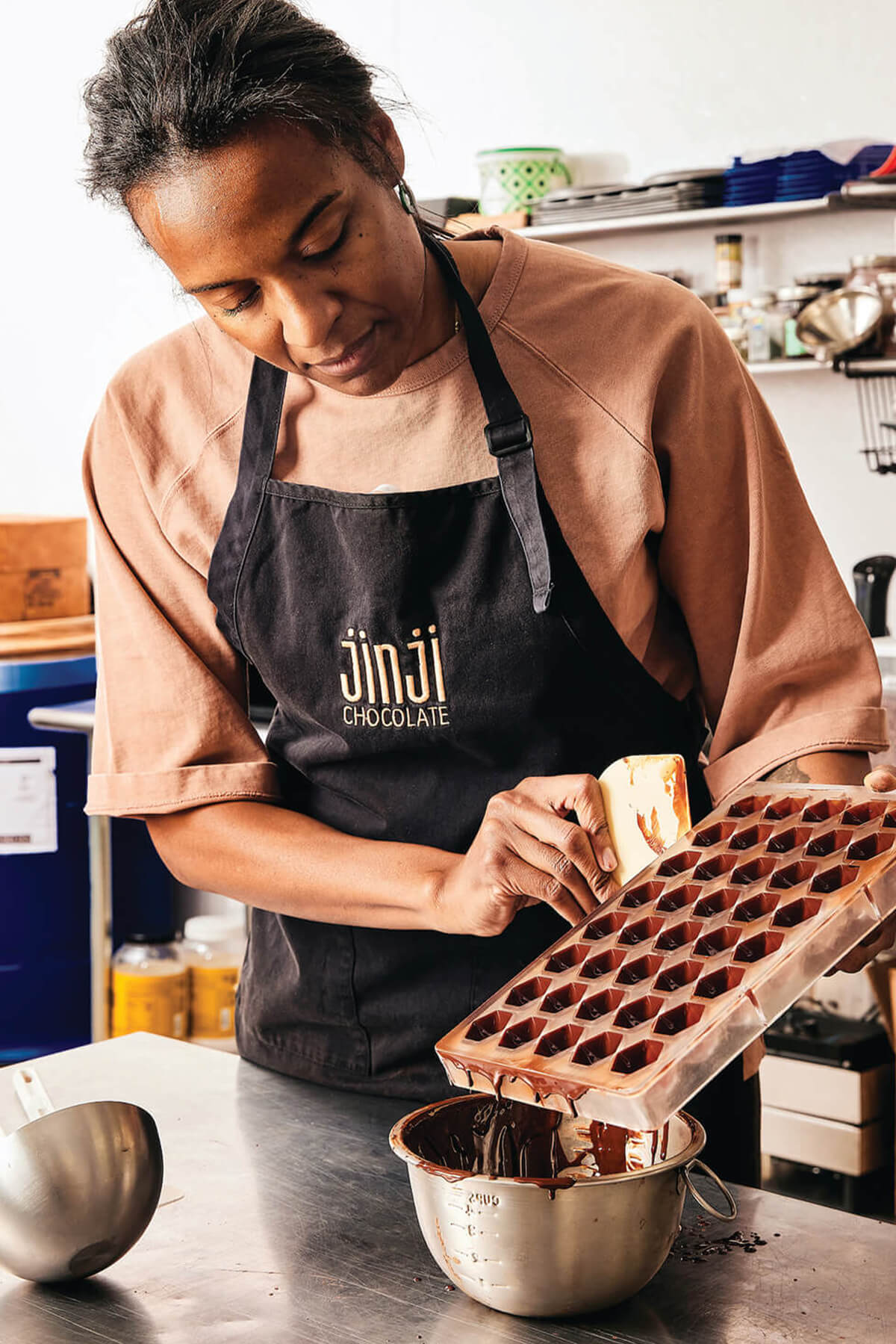
Scenes from the various stages of the
chocolate-making process.
Relaxing in her airy Lauraville cottage, Fraser sits at her kitchen table surrounded by items that matter to her most: There’s a beaded black-and-white African runner that hangs on the wall, rows of plants on the windowsill, handmade wooden bowls and boards leaning against the counter, family photographs, and a medley of books, including chef Gabrielle Hamilton’s memoir, Blood, Bones & Butter, on a kitchen shelf.
Her pride-and-joy black matte Ducati motorcycle is parked out back in the shed. (“I know it sounds like a cliché, but it’s just you and the wind and freedom,” she says.) Her cozy front porch has two wicker chairs and a well-worn saucer swing strung from the mammoth oak tree on the front lawn. The whole effect reads idyllic oasis.
Wearing a black T-shirt and black leggings, shoeless and makeup-free, the chocolate maker exudes a centeredness and sense of mindfulness that’s so rare, she could teach a master class in calm, even as the mother of an energetic three-year-old who loves drums and dinosaurs. As she reflects on her four decades, she is philosophical. “A lot of days, even if it doesn’t materialize in front of my eyes, something is working, something is happening,” she says between sips of green tea. “I have learned just to trust time.”
Fraser is a big believer in letting life unfold, but thanks to hard work, she’s also made it happen for herself. “There’s the entrepreneurial, analytical, and driven part of her,” affirms general manager Seton, “and having the business fills that side.” But she also believes in astrology and numerology, like when she met her husband, Paul, in 2016, and saw the triple threes in his street address—her lucky number—as a “little nod from the universe.” Fraser acknowledges that can sound a bit woo-woo, but balancing pragmatism with a belief in magic helps her see the meaning in life. “I think those things can coexist,” she says. “I can be a logical, pragmatic person, and I can also believe in magic—and that’s a lovely way to live.”
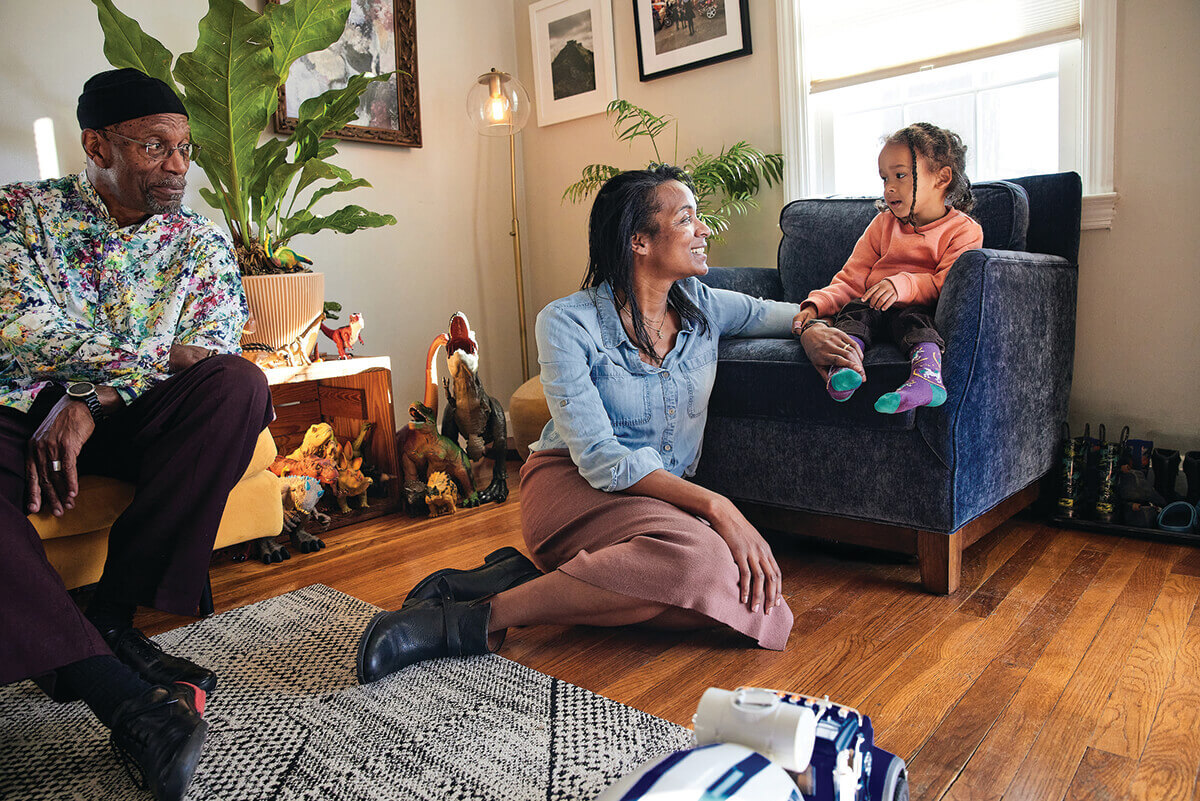
Jinji taking
some family time with her father, Guy,
and son, Stokely.
Fraser’s life began in Heidelberg, Germany, where her father worked for the Army. “I don’t remember it, but I just know I had a good start,” she says. Back in the States, Guy got a job at Aberdeen Proving Grounds and the family moved to Joppatowne in Harford County, where Fraser spent her childhood.
Those formative summers of her youth were spent with extended family in Tuskegee, AL (mom Margaret’s hometown), where she fondly recalls riding in the back of pickup trucks, swimming in lakes, and eating popsicles. “I saw Black life in a way that I never would here—the culture, the food, the language,” says Fraser. “Having that time to learn about my family through this lens was important. Joppatowne was very whitewashed, but I had my friends and sports and school. I loved both places.”
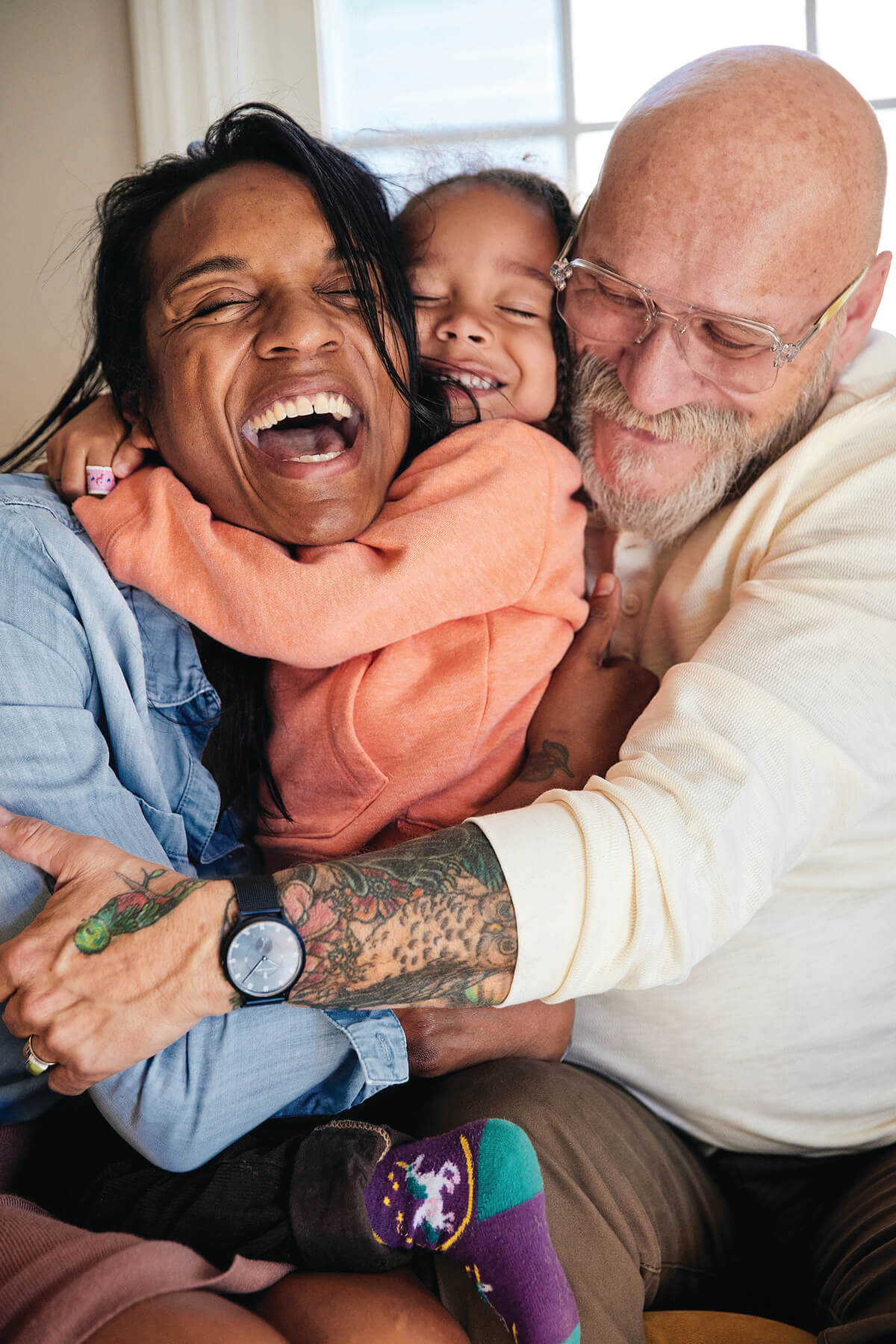
Enjoying a warm hug with her husband, Paul, and Stokely.
Fraser’s path to chocolate-making was anything but linear. At various points, she dreamed of becoming a professional swimmer, kindergarten teacher, and even a fighter pilot. (“I was like, ‘There are no women doing that and it looks like a lot of fun,’” she says with a laugh.) Competitive swimming, however, was her primary pastime. She was recruited for the elite North Baltimore Aquatic Club (NBAC), which she participated in through high school at the McDonogh School in Owings Mills. In 2001, she attended the University of Indiana Bloomington on a full swim scholarship and majored in communications and culture with a minor in criminology. “I really had this fascination with the prison and criminal justice system, thinking I’d work somewhere in that world,” she says.
After graduation in 2005, Fraser landed a job at the nonprofit Maryland Center for Arts and Technology doing job training for out-of-school youth. (It’s also where she met Seton.) A year later, she became a certified holistic health counselor through the Institute for Integrative Nutrition in New York City and bounced between jobs, including one gig at a high-end hair salon in Baltimore. None of these paths stuck, she says, because she had yet to find her purpose. “I was in my 20s and lost and numb and settling for this world that wasn’t mine,” she says.
Seeing her promise and potential, a salon client tried taking Fraser under her wing. “When I was washing her hair, she’d say, ‘Why are you doing this? What are you doing here?’” Eventually, the client secretly slipped Fraser her contact information, telling her to reach out when she was ready to make a change. “One day, I was like, ‘I’m just going to call.’ Something in me knew there was another path.”
That woman was Jeanne Mirchin, who introduced Fraser to her husband, Matthew Mirchin, a bigwig at Under Armour. Ultimately, she was hired as an executive assistant for the company’s co-founder, Scott Plank. “I had no experience whatsoever,” says Fraser, “but I had discipline and was a hard worker and a quick learner.”
As part of her role, she participated in outreach programming at the nonprofit Living Classrooms, teaching out-of-school youth about nutrition. After three years, by 2012, she left UA, hoping to further explore and find her footing in the raw food community. She did menu consultations and worked with area restaurants.
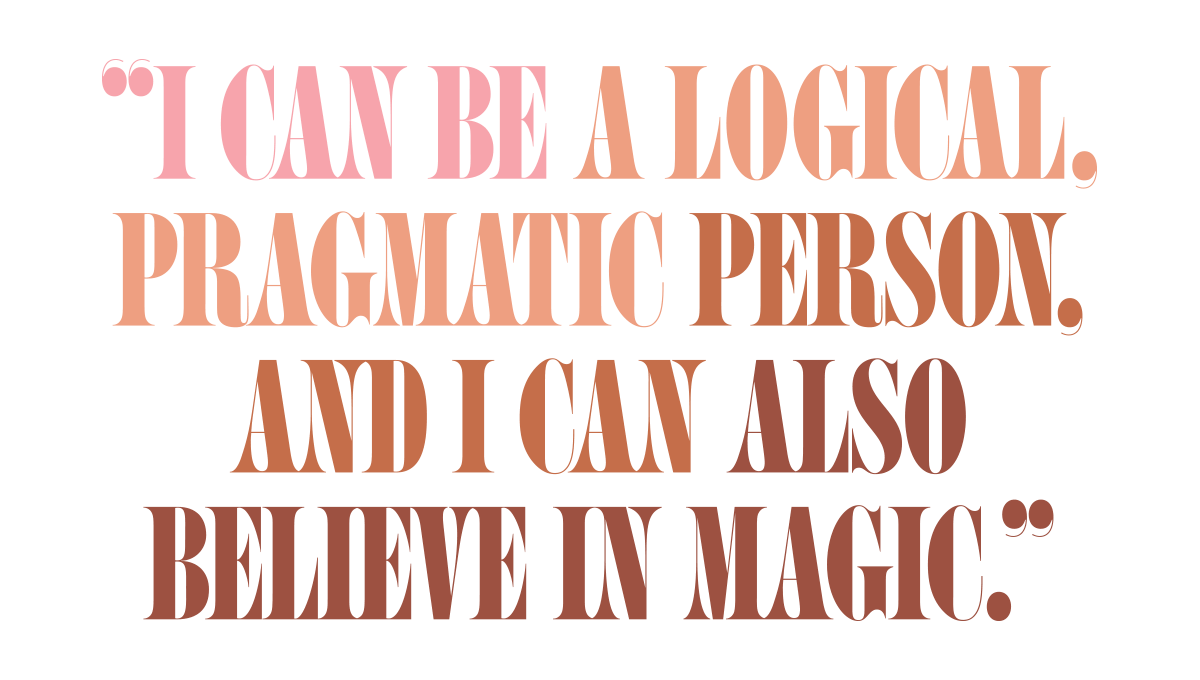
That summer, by a twist of fate, Fraser literally stumbled onto something that would set her path in motion. During a raw food dinner at The Black Olive (hosted by actor Woody Harrelson, no less), she kept stepping on a postcard. Eventually, she picked it up and saw that it was advertising a class for raw chocolate-making. She signed up on a whim and was smitten on the spot. “I loved the sounds of the stone wheels grinding on the stone plate, I loved the technique, I loved that it was this linear process and working with my hands,” says Fraser. “I was entranced.”
Within weeks, with only the one-time workshop under her belt, Fraser launched a wholesale raw chocolate business out of her home kitchen, then in Columbia. “In the beginning, we had no idea what we were doing,” she says, smiling.
But she was, after all, a quick learner. As she started to do research, she learned that while some 40 percent of the work in cacao-growing communities is done by women, they own only about two percent of the land. So, from the outset, sourcing beans from small, family-or female-owned farms became paramount. In addition, Fraser’s chocolate was dairy-free, gluten-free, and vegan, with little refined sugar and no additives—unlike anything else being made in Baltimore—and it remains so to this day. Within months, she was selling to outlets around town, including Woodberry’s Artifact and Remington’s Clavel, where her dark chocolate pastilles were flecked with roasted crickets.
In 2013, when Maryland’s cottage-industry laws governing homemade, commercially sold foods excluded chocolate-making, she could no longer work in her own kitchen. She searched for a commercial space, but rents were prohibitively pricey. Fraser was ready to give up, when she serendipitously ended up back in touch with Scott Plank, who was redeveloping the long-forgotten Belvedere Square Market. When she met with him about being a part of the market, she recalls, “He immediately said, ‘Yes, you can have a space.’ It was a huge deal to get a spot.”
So, on November 22 of that same year, with construction of her stall not yet complete, Fraser set up a makeshift table in the middle of the main market hall. In addition to hazelnut fudge and date poppers, she sold vegan pots de crème and cheesecake made with cashews. “From the first day, I couldn’t believe that people were coming and buying chocolate,” she says. “This was wild to be exposed to the public with this thing that I made. Doing wholesale from my kitchen, I didn’t see the end user. Now someone was standing in front of me, putting this chocolate in their mouth and saying they liked it.”
Very quickly, what was then known as Pure Chocolate by Jinji became a market mainstay. “Jinji had her following, including those who would stop by just to see her,” says Dorian Brown (Stokely’s godfather), whose Neopol Smokery business was a neighbor at Belvedere. “But because the space was so small, sometimes people would just stumble on it—it was the definition of finding a hidden gem.”
With chocolate as their canvas, Fraser and Seton became fascinated by the idea of creating endless iterations of sweet and savory flavors, adding unexpected natural ingredients like sumac, sorrel, mace, morel mushrooms, maitake mushrooms, and more. “Initially, the chocolate was my way of helping people make that transition from crappy, refined food to holistic foods,” says Fraser, who was vegan when she began the business but now eats everything but dairy. “I felt like it could make the process more approachable for people—that was the whole premise. It wasn’t until a few years in that I thought, that’s all well and good, but what else can this be and how else can I add principle and purpose? That’s when our world exploded and expanded into what we are now.”
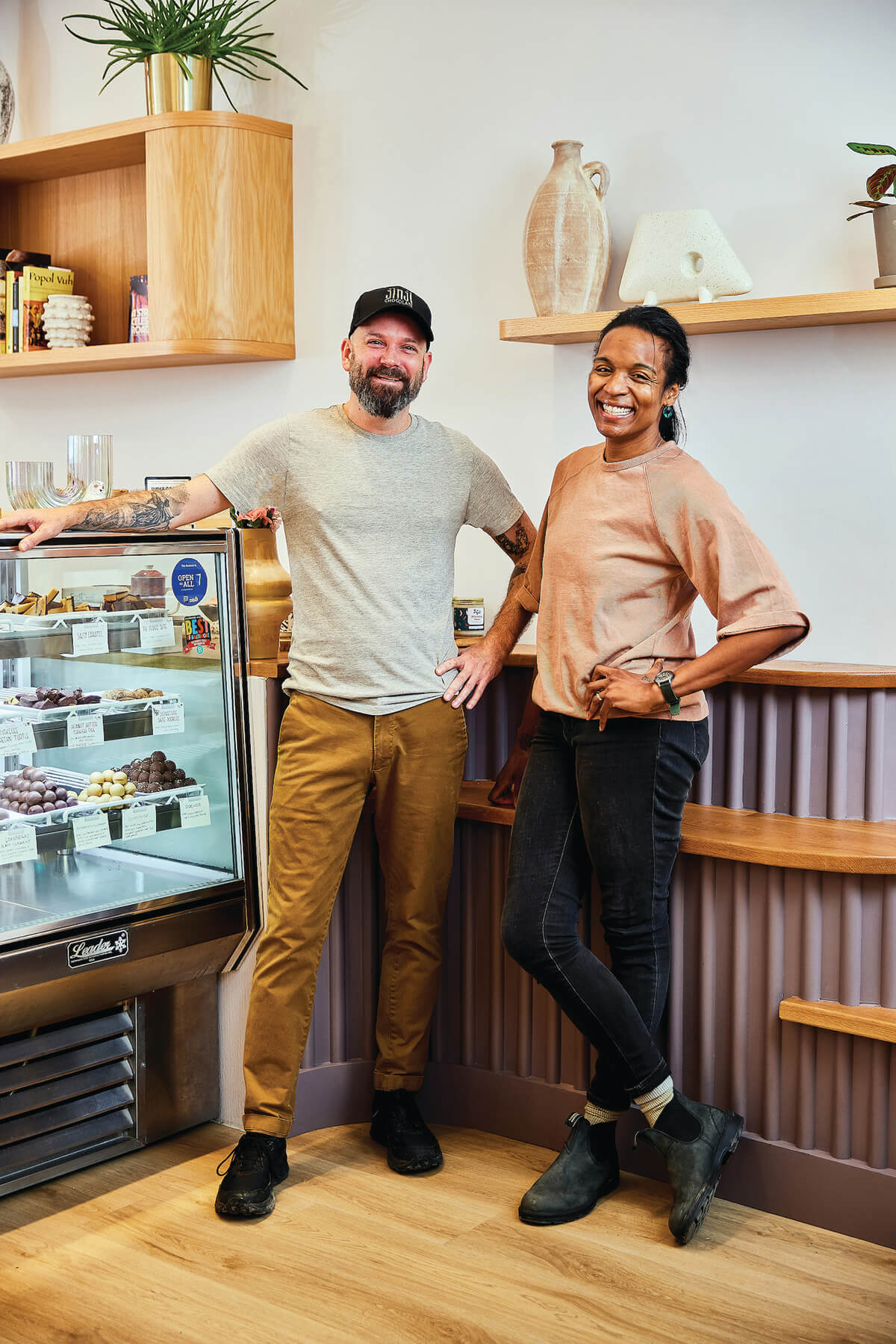
Co-workers and best friends Jonathan Seton and Jinji Fraser hang out in front of the display case at Jinji Chocolate.
Fraser delved even deeper to learn about the complicated and often overlooked history of chocolate, with its roots entrenched in slavery and colonialism and its fraught production practices that continue to this day. In West Africa, which produces an estimated 70 percent of the world’s cacao beans, it’s a leading cash crop, which fuels serious issues such as deforestation and child labor.
Eager for more education, she and Paul made pilgrimages to nearby cacao-growing countries, as well as the farms where she sourced beans to make her chocolate. Their first trip was to Costa Rica in 2014, followed by Ecuador, Guatemala, Columbia, Mexico, the Caribbean, and the Dominican Republic.
As she traveled, her eyes opened to the troubled past of a plant that has been prized for more than 4,000 years. It is believed the first cacao was cultivated in ancient Mesoamerica (present-day Mexico) and the seeds of the fruit (aka the beans) were rendered into a bitter drink, likely mixed with water, and flavored with spices and flowers, to be used for sacred rituals. On one particularly formative trip to Haiti, she began to appreciate how chocolate-making could, like wine, be something infused with a sense of terroir—tasting and telling the story of the place where it came from. And for her beloved world of chocolate, Fraser wanted to help educate others—and write a new narrative.
“It just blew my mind wide open to see that the possibilities of chocolate are not only in the flavor profiles that we create but also in the production of chocolate itself,” she says. “It made me want to pay homage to this traditional way of chocolate-making—one that was not bound by the rules of European chocolate-making, which is big fancy machines and perfect chocolate bars that are so processed and refined that they hold no reference to the land itself. I was so excited that there was this other way to enjoy chocolate. And yet I felt like my community in Baltimore had no reference.”
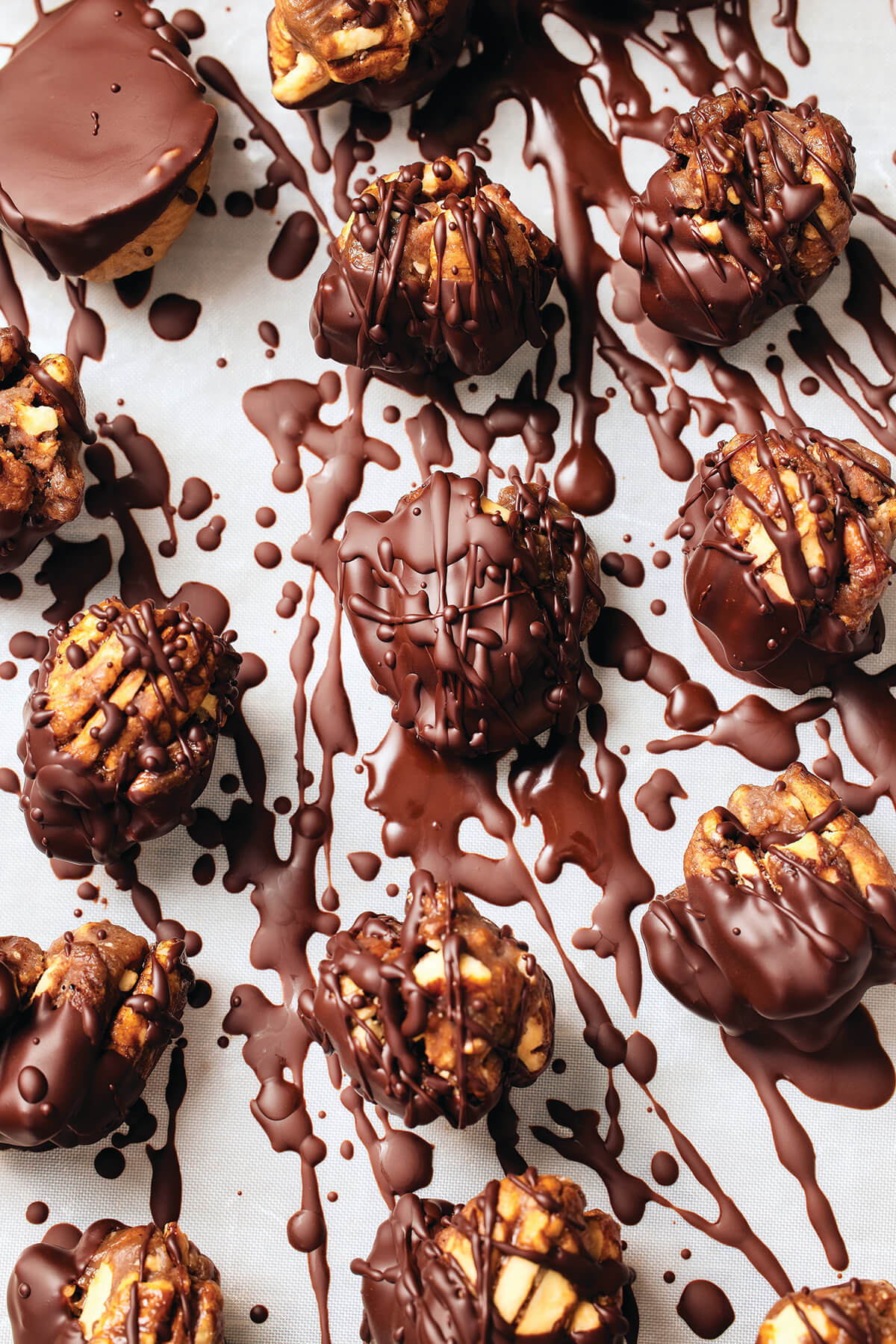
Tuskegee pecan turtles
Back at Jinji Chocolate, Fraser and Seton gear up for the holiday season. The immaculate commercial kitchen is one part art room, with its jars of dried flowers and orange dust, and one part science lab, with its row of spices, stainless steel funnels, measuring cups and massive refrigerator and freezer.
In any given week, the chocolate makers turn out some 1,000 truffles, 1,000 pieces of fudge, and 500 bars, plus an additional 20 to 30 pounds of chocolate to coat coffee beans, date poppers, figs, and peanut brittle, not only for store patrons but for events and wholesale clients, including two area Whole Foods, local bakers like Atwater’s and Motzi Bread, and the revered Black Ankle Vineyards in Frederick County. It’s a labor-intensive process, which means a single bar or truffle can take days to make.
In early December, the co-workers, who refer to each other as “J,” are busier than ever. Making a batch of 72-percent dark chocolate, they mix cacao powder and cacao butter—along with natural sweeteners such as coconut sugar, mesquite, and lucuma fruit—in a melanger (used to grind and refine chocolate) for about 16 hours. This batch will later be used for dipping or drinking.
At the same time, Fraser pops dozens of bonbons from their molds and tweaks new flavor combinations while also reducing pomegranate juice, tearing mint leaves, and consulting her go-to tome, The Flavor Bible, to see if these ingredients will work in combination. “I think it will be delicious,” she says with mock defiance, having expressed doubt just a few minutes earlier. “I have renewed faith in my decision and will continue to pick my mint leaves.” “I think it will be delicious, too,” says Seton reassuringly, as he packages bars of hazelnut gianduja fudge for two upcoming events.
Their friendship is central to the business and creative process, as they bounce ideas off one another, review personal predilections—he’s a cat person, she’s a dog person; he likes horror movies, she doesn’t—and play rounds of “Would you rather?” “Would you rather drink this bottle of olive oil in front of me or eat this entire jar of coconut sugar?” she asks Seton. “I’d definitely drink the olive oil,” he says without hesitation. Belly laughter is the kitchen soundtrack.
Through the years, they’ve dreamed up hundreds of fanciful, idiosyncratic combinations, like tequila-twist truffles with lime, grapefruit, cilantro, and mint, or cashew-coconut-Meyer lemon fudge, and, infamously, ketchup and mustard truffles with local tomato ganache and mustard seed garnish. “Why bring it up?” Fraser scolds Seton teasingly. “We sold exactly two.”
Ideas for flavor profiles are inspired by a variety of places, whether that means “nostalgic food moments of our past,” says Fraser, “or maybe something really tasty and creative we’ve had recently.” They can also be something even bigger, “like a feeling we have in response to something in the world around us that we then distill into a flavor,” she says. “Or it could be as simple as a classic holiday favorite.”
Learning the art of chocolate-making has mostly been trial and error. “We are learning all the time as we go,” says Seton. “Craft chocolate-making doesn’t necessarily have a set of rules. It’s what your creativity and imagination and your soul ends up delivering.”
Beyond the science itself, there’s “an element of real magic with chocolate-making,” adds Fraser. “What works one day won’t work the next. What flavor is good the first time doesn’t jibe with the chocolate the next. There’s the science, for sure, but chocolate doesn’t care about mastery.”
Like the time the melanger vibrated straight off the counter in the middle of the night and splattered chocolate all over the kitchen. “It was a horror scene,” Fraser recalls.
It keeps them humble, and on their toes.
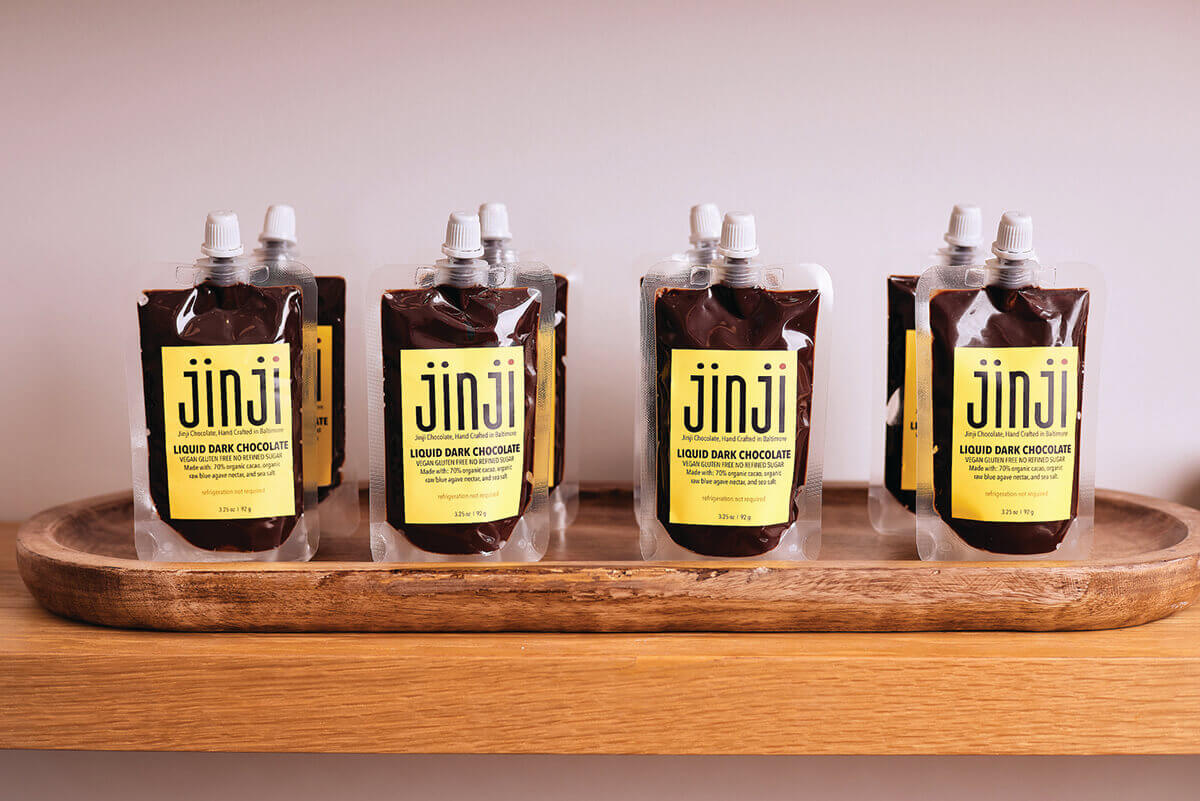
Pouches of Fraser's vegan and gluten-free liquid dark chocolate made with 70-percent organic cacao.
Which is why Fraser especially loves being able to showcase the very basics and origins of chocolate through the new shop’s authentic “drinking bar”—likely the only one in the state. Preparing cups of liquid chocolate for customers, she ferments just-roasted beans to form cacao nibs, which are then milled to a dark paste, which is then mixed with oat milk, unrefined cane sugar, and simple syrup, before finally being steamed to yield a rich drinking chocolate, much like what indigenous cultures drink to this day.
Of course, incorporating traditional practices has long been at the core of Fraser’s professional mission, but it became something of a personal calling ever since she learned her own ancestors can be traced back at least three generations to an ancient cacao-growing region bordered by Brazil, Venezuela, and the Atlantic Ocean. “It turns out Guyana is our ancestral homeland,” she says. “And there’s a Fraser family trust there—I had no idea.”
And when she did a little digging about exactly where—just west of the capital city of Georgetown—she was stunned by the serendipity. “That land is squarely in cacao-rich earth,” she says. “It felt like they had spoken to us and put this path right in front of us. It was like all the roads led to this. And it was a crazy, cathartic feeling. Like, ‘You’ve always been meant to be here. This is the thing you’re supposed to be doing.’”
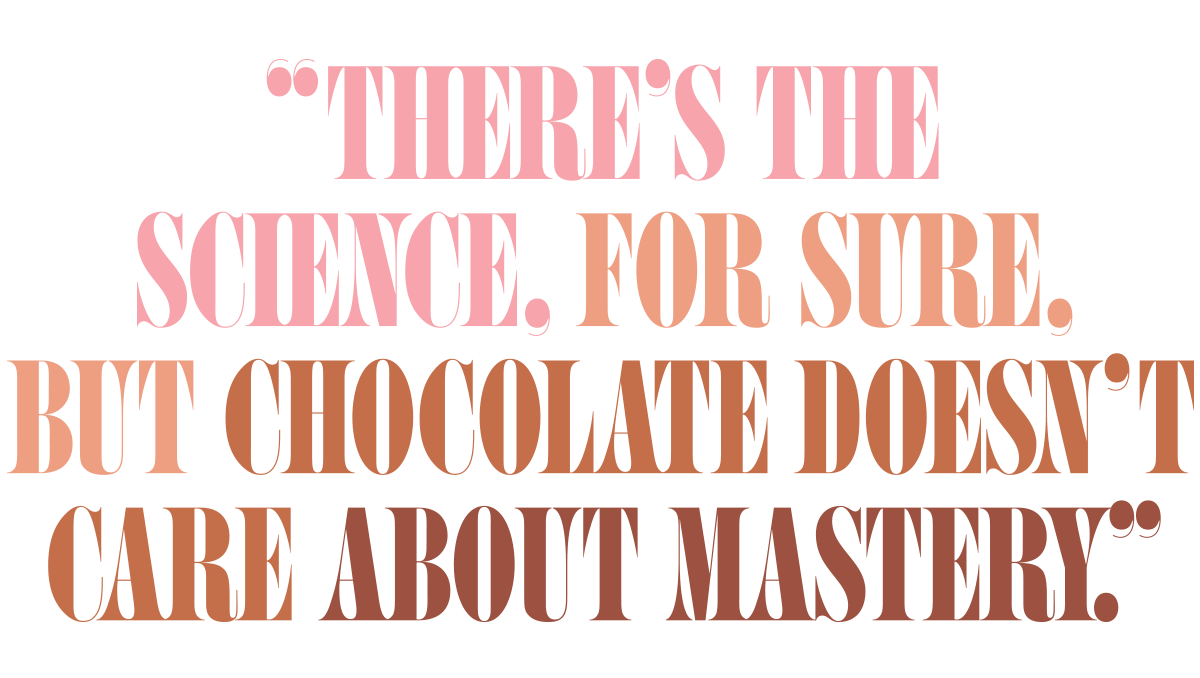
Fraser often circles back to her sense of purpose. While standing in her new space, she can’t help but reflect on the old one at Belvedere Square Market and connect the dots of her path. “We were an afterthought,” she says of her minuscule market booth, which was positioned as a stop for customers on the way to somewhere else. It mirrored the feeling of being marginalized throughout her lifetime—as one of the only Black students in elementary school, as a bit of an outsider on the swim team, and while attending McDonogh. “I thought this was just my place in people’s lives—right there on the edge,” she says.
But for Fraser, being on the fringes likely played a part in her path—and her purpose. That thought has dislodged something. She’s had an epiphany these past few weeks, and says it’s been life-changing.
“I feel like this could have been the way I experienced racism—being the only one in those circles,” she says. “In the moment, the way I was received by my friends, by the people I was around, felt kind and gentle. In retrospect, I was always on the edge of those friendships. I was never the best friend. I was never at the center.”
Carving out her own space has come to carry real weight.
“Being here is breaking that cycle,” she says. “It feels very healing to have this beautiful shop and to have people come especially for this—they walk in the door because that’s exactly where they want to be. They come to see us because we are exactly who they expected to be there.”
In other words, right on cue, the universe, and Jinji, have arrived.

